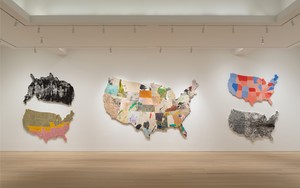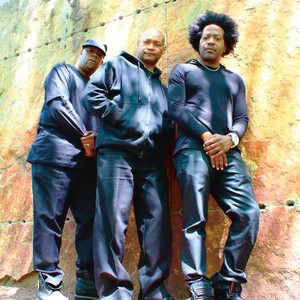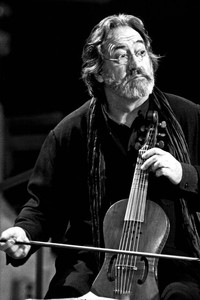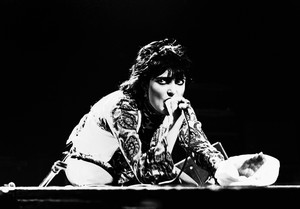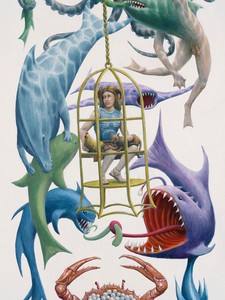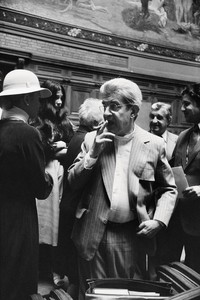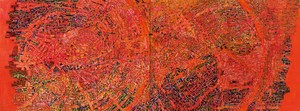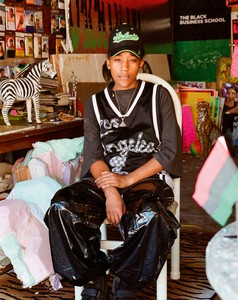In Never Remember, the exhibition by Nate Lowman now on view in New York, one painting stands out among the various iterations on the theme of the United States map. Entitled Nov 8, 2016, it is based on the chart of the 2016 presidential election showing the states won by Donald Trump and those won by Hillary Clinton. In an exhibition of works displaying a wide range of colors and patterns, this is the only piece that uses variations on just two colors, pink and blue.
I asked Lowman about what he calls “the 2016 Trump election map” when I spoke with him for the essay I wrote for the exhibition’s accompanying catalogue. “That was not something I intended to make a painting of, but as I worked on the show I thought it would be an interesting challenge to make a painting I like to look at that followed that map—the one showing the states Trump won on Election Night. Because I don’t like looking at that map. It’s a source of anxiety. I tried to make something awesome that I wanted to look at every day using the colors that I love—pink, which is my favorite color, and light blue, a Matisse blue. People have an interesting reaction to the painting—it’s yes and no, it’s good and bad, it’s simple and complicated.”
Of all the paintings in the show, Nov 8, 2016, made this year, is the one that is the most obviously political. Yet one cannot view the exhibition as a whole, with its multiple interpretations of the US map, outside the spectrum of politics, especially at a time when nationalism, and what exactly nationalism means in the current cultural climate, is at the forefront of the national debate. Still, Lowman did not want his art to make an overtly political statement; he was more interested in examining the issue of borders. “I would like to address this, as much as one can in the obscure language of painting,” he told me. “However crazy the current discourse is, why are we so obsessed about firming up our borders, when they will inevitably be in flux? Because they always have been.”
As it happens, Never Remember is presented in the same gallery space that, in February and March of 1989, featured Jasper Johns: The Maps, Johns’s now-legendary meditation on the US map. Of the thirteen canvases in that show, the most famous is the iconic Map (1961), which now hangs in the Museum of Modern Art in New York. The way the Johns show was contextualized—at a time when the country was transitioning from the administration of Ronald Reagan to that of George H.W. Bush—is telling.
In her essay in the exhibition catalogue, art historian Roberta Bernstein debates whether Johns’s map paintings are personal. She writes: “The map is a subject which could be interpreted to have personal meaning, if certain areas were made to stand out from others. But Johns paints the map the way he paints all of his other works: each area of the surface (here, each location of the map) is of equal importance.” In the New York Times, critic John Russell seemed fixated on the number and size of the paintings: “Even to those who are familiar with Johns’s work, this show will prove a revelation. All the images are based on the standard maps of the United States, with stenciled names for the states and an indication of the seas or oceans that surround this country.” What was not mentioned in either the catalogue essay or the reviews (as exemplified by the Times) was politics. The nation had just been governed for eight years by a president who called the Soviet Union an “evil” empire, it was about to be governed by a man who was once the director of the CIA, and yet a show about the map of the nation seemed strangely devoid of any echoes of nationalism.
In 2008, many observers believed the election of Barack Obama as the first African-American president signaled a fundamental shift in the nation’s psyche. Unfortunately, what has emerged since is a new nationalism, defined by isolationism and not-so-subtle racism, that the country has not witnessed since George Wallace and, before that, Huey Long. This new nationalism will dominate until the voting groups that combined to elect Obama reassert themselves.
That’s why voting on November 6 is vital. Few, if any, midterm elections have ever been this consequential.
Lowman’s Never Remember, especially Untitled (2013–15), a mixed-media presentation of the US map so massive that the wall on which it is presented has to be tilted backwards, reminds the viewer of the grandeur of America. It is at the ballot box that this grandeur is celebrated—and protected.

